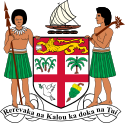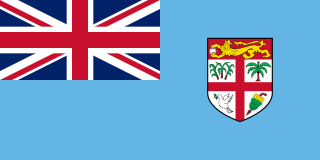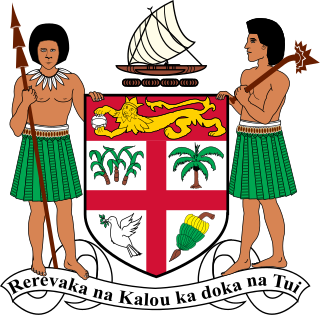 |
|---|
General elections were held in Fiji in July, August and September 1920. [1]
 |
|---|
General elections were held in Fiji in July, August and September 1920. [1]
The Legislative Council consisted of 12 official members (eleven civil servants and a British subject not holding public office), [2] seven elected Europeans and two appointed Fijians. The Governor served as President of the Council. [1]
The Europeans were elected from six constituencies; Eastern, Northern, Southern, Suva, Vanua Levu & Taveuni and Western. Voting was restricted to men aged 21 or over who had been born to European parents (or a European father and was able to read, speak and write English) who were British subjects and had been continuously resident in Fiji for 12 months, either owning at least £20 of freehold or leasehold property or having an annual income of at least £120, and were not on the public payroll. [2]
| Constituency | Geographical area | Election date |
|---|---|---|
| Eastern | Lau Province, Lomaiviti Province | 30 July [1] |
| Northern | Ba District, Colo North Province, Ra Province | 6 September |
| Southern | Colo East Province, Kadavu Province, Naitasiri Province, Namosi Province, Rewa Province (except Suva), Serua Province, Tailevu Province | 2 September |
| Suva | Suva Municipality | 21 August |
| Vanua Levu and Taveuni | Bua Province, Cakaudrove Province, Macuata Province | 2 September |
| Western | Colo West Province, Lautoka District, Nadi District, Nadroga Province | 3 September |
| Constituency | Candidate | Votes | % | Notes |
|---|---|---|---|---|
| Eastern | John Maynard Hedstrom | Unopposed | Re-elected | |
| Northern | Frederick Clapcott | 60 | 58.3 | Re-elected |
| L. Davidson | 42 | 40.8 | ||
| N.S. Chalmers | 1 | 1.0 | ||
| Southern | Francis Riemenschneider | 80 | 55.9 | Elected |
| Robert Crompton | 63 | 44.1 | Unseated | |
| Informal votes | 1 | – | ||
| Suva | Henry Milne Scott | 242 | 36.3 | Re-elected |
| Henry Marks | 194 | 29.1 | Re-elected | |
| S.H. Ellis | 123 | 18.5 | ||
| James Burton Turner | 107 | 16.1 | ||
| Vanua Levu & Taveuni | Herbert Valentine Tarte | 62 | 45.9 | Elected |
| W.C. Fisher | 38 | 28.1 | ||
| E. Duncan | 35 | 25.9 | ||
| Informal votes | 3 | – | ||
| Western | Charles Wimbledon Thomas | 63 | 56.3 | Elected |
| John Percy Bayly | 49 | 43.8 | ||
| Informal votes | 4 | – | ||
| Source: Ali | ||||
The nominated members were appointed on 15 October; one of the Fijian posts was left unfilled. [1]
| Position | Member |
|---|---|
| Governor (President) | Cecil Hunter-Rodwell |
| Agent-General of Immigration | Percy Robert Backhouse |
| Attorney General | Alfred Karney Young |
| Chief Medical Officer | George Cecil Strathairn |
| Colonial Postmaster | Herbert Paul St. Julian |
| Colonial Secretary | Thomas Edward Fell |
| Commissioner of Lands | Dyson Blair |
| Commissioner of Works | Henry Berry Lees |
| District Commissioner, Rewa | Richard Rutledge Kane |
| Receiver General | William Henry Brabant |
| Secretary for Native Affairs | Douglas Ray Stewart |
| Superintendent of Agriculture | Charles Henry Knowles |
| Representing Indo-Fijians | Badri Maharaj |
| Fijian member | Joni Antonio Rabici |
| Source: Fiji Blue Book [1] | |
A by-election was held for the Vanua Levu and Taveuni seat on 4 October 1922, which was won by William Edmund Willoughby-Tottenham. [3]

Fiji, officially the Republic of Fiji, is an island country in Melanesia, part of Oceania in the South Pacific Ocean. It lies about 1,100 nautical miles north-northeast of New Zealand. Fiji consists of an archipelago of more than 330 islands—of which about 110 are permanently inhabited—and more than 500 islets, amounting to a total land area of about 18,300 square kilometres (7,100 sq mi). The most outlying island group is Ono-i-Lau. About 87% of the total population of 924,610 live on the two major islands, Viti Levu and Vanua Levu. About three-quarters of Fijians live on Viti Levu's coasts, either in the capital city of Suva, or in smaller urban centres such as Nadi or Lautoka. The interior of Viti Levu is sparsely inhabited because of its terrain.

Vanua Levu, formerly known as Sandalwood Island, is the second largest island of Fiji. Located 64 kilometres to the north of the larger Viti Levu, the island has an area of 5,587.1 square kilometres (2,157.2 sq mi) and a population of 135,961 as of 2007.

Savusavu is a town in the Fijian Province of Cakaudrove. The town is located on the south coast of Vanua Levu Island and had a population of 3,372 in the 2007 census.
Located in the central Pacific Ocean, Fiji's geography has made it both a destination and a crossroads for migrations for many centuries.

Taveuni is the third-largest island in Fiji, after Viti Levu and Vanua Levu, with a total land area of 434 square kilometres. The cigar-shaped island, a massive shield volcano which rises from the floor of the Pacific Ocean, is situated 6.5 kilometres east of Vanua Levu, across the Somosomo Strait. It belongs to the Vanua Levu Group of islands and is part of Fiji's Cakaudrove Province within the Northern Division.
Cakaudrove is one of fourteen provinces of Fiji, and one of three based principally on the northern island of Vanua Levu, occupying the south-eastern third of the island and including the nearby islands of Taveuni, Rabi, Kioa, and numerous other islands in the Vanua Levu Group. It has a total land area of 2,816 square kilometers, with a population of 50,469 at the most recent census in 2017, making it the seventh most populous province. The only major town is Savusavu, with a population of 3,372 in 2007.
James Ranchandar Rao was one of the three Indo-Fijians elected to the Legislative Council of Fiji in October 1929 when Indo-Fijians were given the first opportunity to elect their own representatives in the 1929 elections. The other two were Vishnu Deo and Parmanand Singh.

James Madhavan was an Indo-Fijian politician. He was a member of the Legislative Council and House of Representatives for most of the period between 1947 and 1973 and had two spells in the Executive Council.

The Diocese of Polynesia, or the Tikanga Pasefika serves Anglicans in Fiji, Tonga, Samoa and the Cook Islands, within the Anglican Church in Aotearoa, New Zealand and Polynesia. The diocese's first bishop was consecrated in 1908. The diocese's cathedral is Holy Trinity Cathedral in Suva, Fiji.

The majority of Fiji's islands were formed through volcanic activity starting around 150 million years ago. Today, some geothermic activity still occurs on the islands of Vanua Levu and Taveuni. Fiji was settled first by the Lapita culture, around 1,500–1,000 years BC, followed by a large influx of people with predominantly Melanesian genetics about the time of the beginning of the Common Era. Europeans visited Fiji from the 17th century, and, after a brief period as an independent kingdom, the British established the Colony of Fiji in 1874. Fiji was a Crown colony until 1970, when it gained independence as the Dominion of Fiji. A republic was declared in 1987, following a series of coups d'état.

General elections were held in Fiji on 23 March and 10 April 1908.

General elections were held in Fiji between 19 May and 20 June 1914.

General elections were held in Fiji in June and July 1917.

General elections were held in Fiji in 1923.

General elections were held in Fiji in 1926.

General elections were held in Fiji on 31 August 1932, although only one of the nine elected seats was contested.

General elections were held in Fiji on 29 July 1944. The term of the Legislative Council elected in 1940 was due to end in 1943, but was extended by a year by the Governor.

Abortive elections to a Corporation of European settlers were held in Fiji in 1870.
Major William Edmund Willoughby-Tottenham was British army major and later a politician in Fiji, where he served as a member of the Legislative Council in two spells between 1922 and 1937.
Herbert Valentine Tarte (1876–1936) was a Fijian planter and politician. He served in the Legislative Council in the early 1920s.